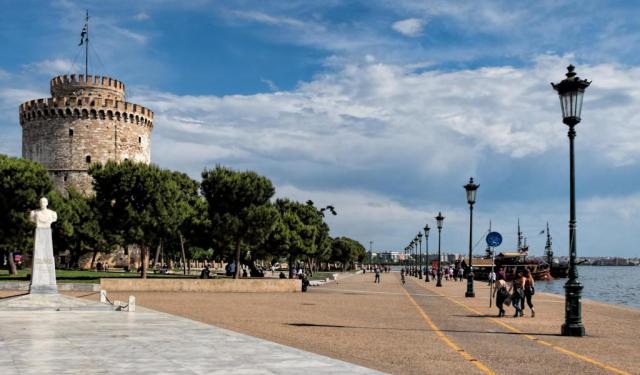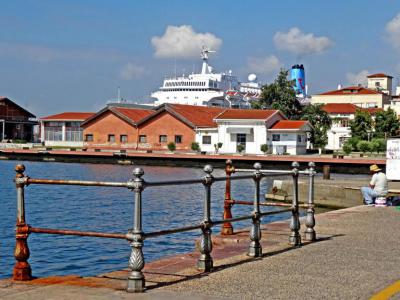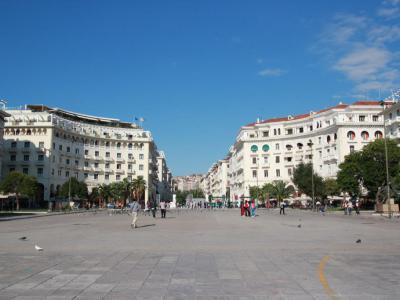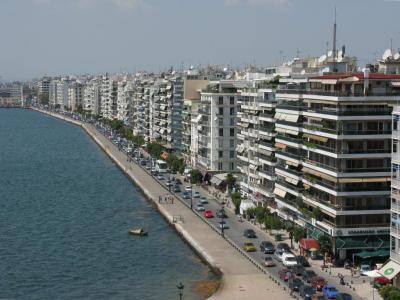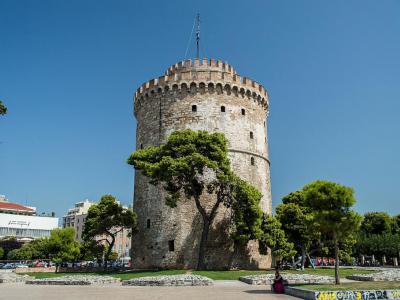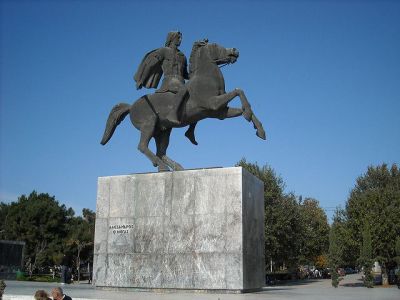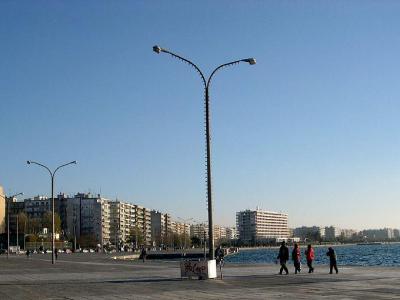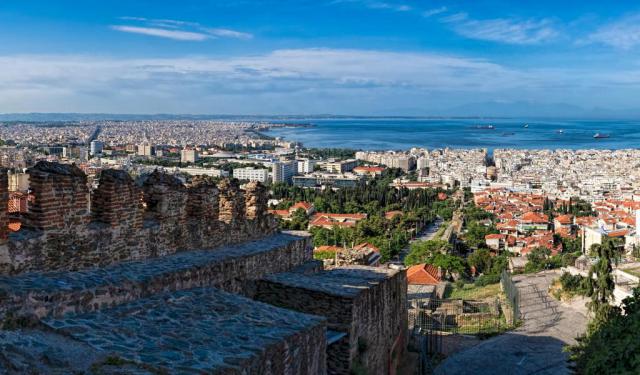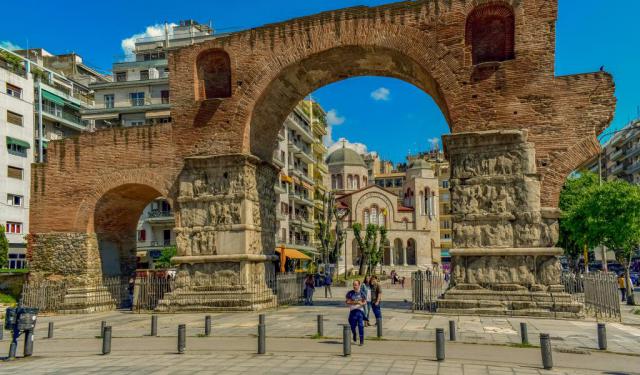Thessaloniki Waterfront Tour (Self Guided), Thessaloniki
The Mediterranean has always been an integral part of Thessaloniki’s appeal. The city's orientation toward the sea is largely due to the vision of Ernest Hébrard, the French urban planner and architect, who redesigned the downtown area after the devastating fire of 1917.
To really get the taste of Thessaloniki you need to visit not just its historical landmarks, but also those spots that keep adding new tales. Heading east from the Port you will find plenty of both worth checking out.
While the architecturally indifferent buildings near the Port mostly house shipping and law offices, the view changes dramatically from Aristotelous Square onwards, segueing into luxurious apartment blocks and some of the most expensive real estate in the city. Nikis Avenue, complete with Palia Paralia (Old Waterfront), is one such place.
Walking for a few minutes more will bring you to the White Tower, the city’s most emblematic landmark and museum, and the point where the Nea Paralia (New Waterfront) begins – an ambitious renovation designed by architects Prodromos Nikiforidis and Bernard Cuomo. Being 3,5km in length, the New Waterfront offers a pleasant alternative for a walk with children.
Along the beach, you will find a number of theme parks. One of them is dedicated to Alexander the Great, the ancient military commander and king of the Macedonians whose mounted statue, featuring his favorite horse Bucephalus, is found right here.
To explore the lovely waterfront area of Thessaloniki at your own pace and in your good time, take this self-guided walking tour and enjoy yourself!
To really get the taste of Thessaloniki you need to visit not just its historical landmarks, but also those spots that keep adding new tales. Heading east from the Port you will find plenty of both worth checking out.
While the architecturally indifferent buildings near the Port mostly house shipping and law offices, the view changes dramatically from Aristotelous Square onwards, segueing into luxurious apartment blocks and some of the most expensive real estate in the city. Nikis Avenue, complete with Palia Paralia (Old Waterfront), is one such place.
Walking for a few minutes more will bring you to the White Tower, the city’s most emblematic landmark and museum, and the point where the Nea Paralia (New Waterfront) begins – an ambitious renovation designed by architects Prodromos Nikiforidis and Bernard Cuomo. Being 3,5km in length, the New Waterfront offers a pleasant alternative for a walk with children.
Along the beach, you will find a number of theme parks. One of them is dedicated to Alexander the Great, the ancient military commander and king of the Macedonians whose mounted statue, featuring his favorite horse Bucephalus, is found right here.
To explore the lovely waterfront area of Thessaloniki at your own pace and in your good time, take this self-guided walking tour and enjoy yourself!
How it works: Download the app "GPSmyCity: Walks in 1K+ Cities" from Apple App Store or Google Play Store to your mobile phone or tablet. The app turns your mobile device into a personal tour guide and its built-in GPS navigation functions guide you from one tour stop to next. The app works offline, so no data plan is needed when traveling abroad.
Thessaloniki Waterfront Tour Map
Guide Name: Thessaloniki Waterfront Tour
Guide Location: Greece » Thessaloniki (See other walking tours in Thessaloniki)
Guide Type: Self-guided Walking Tour (Sightseeing)
# of Attractions: 6
Tour Duration: 1 Hour(s)
Travel Distance: 2.6 Km or 1.6 Miles
Author: vickyc
Sight(s) Featured in This Guide:
Guide Location: Greece » Thessaloniki (See other walking tours in Thessaloniki)
Guide Type: Self-guided Walking Tour (Sightseeing)
# of Attractions: 6
Tour Duration: 1 Hour(s)
Travel Distance: 2.6 Km or 1.6 Miles
Author: vickyc
Sight(s) Featured in This Guide:
- Port of Thessaloniki
- Aristotelous Square
- Leoforos Nikis/Nikis (Victory) Avenue
- White Tower of Thessaloniki
- Statue of Alexander the Great
- Nea Paralia (New Watefront)
1) Port of Thessaloniki
The Port of Thessaloniki, situated in Thessaloniki, Greece, stands as a significant maritime hub, deeply intertwined with the city's economic history and development. Renowned for being one of the largest ports in the Eastern Mediterranean, it plays a crucial role in bridging southeastern Europe and the Balkans with maritime routes across the globe. This bustling port specializes in handling both shipping containers and general cargo, making it a pivotal point for trade in the region.
Strategically connected to both national and international rail networks, the Port of Thessaloniki ensures seamless distribution of goods, underscoring its importance in the global logistics chain. Its historical significance is also notable; during World War I, it served as a base of operations for the Allies. In a darker chapter of history, during World War II, the port was seized by Germany, which then used it as a departure point for the deportation of Thessaloniki's Jewish population to Poland.
The port also boasts one of the Aegean Sea's largest passenger terminals, housed in a building steeped in history. Originally constructed in 1912 as a customs house, this building now welcomes thousands of tourists, as Thessaloniki has emerged as a favored cruise destination. Its passenger terminal's proximity to the city's main attractions further enhances its appeal, offering easy access to Thessaloniki's rich cultural and historical landmarks. The Port of Thessaloniki, thus, not only serves as a vital commercial gateway but also as a point of convergence for cultural exchanges, making it a cornerstone of Thessaloniki's vibrant identity.
Strategically connected to both national and international rail networks, the Port of Thessaloniki ensures seamless distribution of goods, underscoring its importance in the global logistics chain. Its historical significance is also notable; during World War I, it served as a base of operations for the Allies. In a darker chapter of history, during World War II, the port was seized by Germany, which then used it as a departure point for the deportation of Thessaloniki's Jewish population to Poland.
The port also boasts one of the Aegean Sea's largest passenger terminals, housed in a building steeped in history. Originally constructed in 1912 as a customs house, this building now welcomes thousands of tourists, as Thessaloniki has emerged as a favored cruise destination. Its passenger terminal's proximity to the city's main attractions further enhances its appeal, offering easy access to Thessaloniki's rich cultural and historical landmarks. The Port of Thessaloniki, thus, not only serves as a vital commercial gateway but also as a point of convergence for cultural exchanges, making it a cornerstone of Thessaloniki's vibrant identity.
2) Aristotelous Square (must see)
It was August, 1917. Greece had taken the Allied side in the Great War and the city of Thessaloniki was teeming with British and French troops and refugees from Turkey. In a small house of refugees at OLympiados 3, an ember from the kitchen fire set some straw alight. The fire spread, driven by the wind, and Thessaloniki burned for two days.
French architect Ernest Hebrard was in town. Prime Minister Eleftherios Venizelos forbade any reconstruction without a modern plan and he commissioned Hebrard for the job.
Hebrard came up with a city-wide plan of large squares and broad avenues and buildings with imposing facades derived from Byzantine elements. Among the large squares was Alexander the Great Square, now called Aristotelous Square.
A monumental axis stretches from sea-facing Aristotelous Square to Dikastirion Square and the Roman Forum. Looking uphill from the square one can see the ancient Byzantine walls of the city. A statue of Alexander the Great rides the waterfront esplanade of the square. Eleftherios Venizelos raises his right hand in benediction.
Aristotle relaxes in his chiton and sandals. The big toe of his left foot shines from rubbings of students hoping his wisdom will rub off. The square is a venue for rallies and demonstrations and cultural events, including annual Christmas and carnival celebrations.
The square is also home to several landmark buildings, such as the Electra Palace Hotel. This iconic hotel features stunning architecture and lavish interior decorations. In addition, visitors can check out the Orizontes Roof Garden and enjoy a spectacular waterfront view while dining or enjoying a cocktail.
The Olympion Theatre Cinema is another popular attraction. The neoclassical Olympion hosts the annual International Film Festival of Thessalonica. This film festival began in 1960 and facilities film viewers to discuss the chosen movies with film directors.
French architect Ernest Hebrard was in town. Prime Minister Eleftherios Venizelos forbade any reconstruction without a modern plan and he commissioned Hebrard for the job.
Hebrard came up with a city-wide plan of large squares and broad avenues and buildings with imposing facades derived from Byzantine elements. Among the large squares was Alexander the Great Square, now called Aristotelous Square.
A monumental axis stretches from sea-facing Aristotelous Square to Dikastirion Square and the Roman Forum. Looking uphill from the square one can see the ancient Byzantine walls of the city. A statue of Alexander the Great rides the waterfront esplanade of the square. Eleftherios Venizelos raises his right hand in benediction.
Aristotle relaxes in his chiton and sandals. The big toe of his left foot shines from rubbings of students hoping his wisdom will rub off. The square is a venue for rallies and demonstrations and cultural events, including annual Christmas and carnival celebrations.
The square is also home to several landmark buildings, such as the Electra Palace Hotel. This iconic hotel features stunning architecture and lavish interior decorations. In addition, visitors can check out the Orizontes Roof Garden and enjoy a spectacular waterfront view while dining or enjoying a cocktail.
The Olympion Theatre Cinema is another popular attraction. The neoclassical Olympion hosts the annual International Film Festival of Thessalonica. This film festival began in 1960 and facilities film viewers to discuss the chosen movies with film directors.
3) Leoforos Nikis/Nikis (Victory) Avenue
Victory Avenue (Leoforos Nikis) stands out as the most renowned and bustling shopping street in the heart of Thessaloniki. It's a place that's constantly captured in photographs and paintings, and it boasts the highest property prices in the city. This three-line central street, also known as Old Waterfront, runs from Eleftherias Square and the Port, all the way along the coast, past Aristotelous Square, towards the White Tower and Alexander the Great Avenue.
As a prestigious location, Victory/Nikis Avenue is home to some of the most luxurious residences and commercial spaces in the city, as well as hosting several foreign consulates. It's a hub for commerce and entertainment, housing the finest nightclubs, numerous bars, restaurants, and retail stores that attract both tourists and locals alike. Throughout its history, it has been the site of iconic cafes, patisseries, historic cinemas, and luxury hotels along the seafront.
Originally known by different names like "Beyaz Kule Avenue" during Ottoman rule and "Vasileos Konstantinou Avenue" until 1939, it was finally named "Nikis Avenue" in 1939 to commemorate the victory in the Balkan Wars of 1912-13. The wide pedestrian sidewalk along the waterfront remains a popular spot for visitors and locals to enjoy strolls while taking in the breathtaking sea views.
As a prestigious location, Victory/Nikis Avenue is home to some of the most luxurious residences and commercial spaces in the city, as well as hosting several foreign consulates. It's a hub for commerce and entertainment, housing the finest nightclubs, numerous bars, restaurants, and retail stores that attract both tourists and locals alike. Throughout its history, it has been the site of iconic cafes, patisseries, historic cinemas, and luxury hotels along the seafront.
Originally known by different names like "Beyaz Kule Avenue" during Ottoman rule and "Vasileos Konstantinou Avenue" until 1939, it was finally named "Nikis Avenue" in 1939 to commemorate the victory in the Balkan Wars of 1912-13. The wide pedestrian sidewalk along the waterfront remains a popular spot for visitors and locals to enjoy strolls while taking in the breathtaking sea views.
4) White Tower of Thessaloniki (must see)
The 23 meters (75 feet) tall White Tower is known as the symbol of Thessaloniki. The Ottomans built the tower around 15th century. It is thought that the fortress was designed by the famous Ottoman architect Mirmar Sinan. It was originally surrounded by fortified walls and was an essential part of Thessaloniki's defenses.
When it was first constructed, it was known as the Lion Tower to honor the Ottoman's victory. The tower was part of the old city's walls and separated the Jewish quarter from the Muslim quarter.
It was renamed the Tower of Kalamaria in the 17th century. It was then used as a garrison. Next, the tower was used as a prison and became known as the Tower of Blood or the Red Tower. During this time, the tower was the site of torture and execution. For example, in 1826, Sultan Mahmud II ordered the massacre of the rebellious Janissaries imprisoned in the tower.
Finally, the tower was painted white in 1891 and named the White Tower. Some historians suggest that the Ottoman Empire sought to "whitewash" the tower's brutal torture history with a change of paint and a new name. While the truth behind the change is unknown, the White Tower name has stuck.
King George I of Greece was assassinated near the White Tower in 1913. Hopefully this was the last drop of blood for the White Tower.
The tower served as an Allied forces communication center during World War I. At this time, the defensive walls were taken down. The White Tower also protected priceless antiquities during World War I.
Thessaloniki's air defense operated from the tower from 1912 to 1983. The tower also housed a meteorological laboratory.
Visitors can enjoy expansive views of the city and Thermaic Gulf from the top floor. In addition, the promenade in front of the tower is a popular spot for photos and meetings.
The White Tower is home to a museum that celebrates Thessaloniki's history. Exhibitions explore the city's history from its founding in 316 BC to today.
When it was first constructed, it was known as the Lion Tower to honor the Ottoman's victory. The tower was part of the old city's walls and separated the Jewish quarter from the Muslim quarter.
It was renamed the Tower of Kalamaria in the 17th century. It was then used as a garrison. Next, the tower was used as a prison and became known as the Tower of Blood or the Red Tower. During this time, the tower was the site of torture and execution. For example, in 1826, Sultan Mahmud II ordered the massacre of the rebellious Janissaries imprisoned in the tower.
Finally, the tower was painted white in 1891 and named the White Tower. Some historians suggest that the Ottoman Empire sought to "whitewash" the tower's brutal torture history with a change of paint and a new name. While the truth behind the change is unknown, the White Tower name has stuck.
King George I of Greece was assassinated near the White Tower in 1913. Hopefully this was the last drop of blood for the White Tower.
The tower served as an Allied forces communication center during World War I. At this time, the defensive walls were taken down. The White Tower also protected priceless antiquities during World War I.
Thessaloniki's air defense operated from the tower from 1912 to 1983. The tower also housed a meteorological laboratory.
Visitors can enjoy expansive views of the city and Thermaic Gulf from the top floor. In addition, the promenade in front of the tower is a popular spot for photos and meetings.
The White Tower is home to a museum that celebrates Thessaloniki's history. Exhibitions explore the city's history from its founding in 316 BC to today.
5) Statue of Alexander the Great
The statue of Alexander the Great shows Alexander the Great riding his horse Bucephalus. The monument is six meters (20 feet) tall. Its height, including the pedestal, is 11 meters (36 feet) tall. The bronze statue was crafted in 1973 by sculptor Evangelos Moustakas.
Alexander the Great was one of the world's most influential politicians and historical figures. Alexander the Great was one of Aristotle's students and became a Macedonian Emperor at 20. He conquered large swaths of land, including Egypt, Palestine, Syria, Pakistan, Iran, and Turkey.
Alexander the Great was undefeated in battle. But, unusually, he didn't seek to change the beliefs or customs of the territories he conquered.
The statue shows Alexander looking east while his faithful horse Bucephalus seems ready to fight. Behind the statue, a low wall depicts the Battle of Issus, which happened in 333 BC. During the battle, Alexander the Great defeated the Persian king Darius III. Other features show shields depicting Alexander's army, a snake, a lion, an ox, a falcon, and Gorgon Medusa.
Alexander the Great was incredibly influential in Macedonia and the ancient world. Thessaloniki was named after Alexander the Great's half-sister, Thessalonike.
The statue overlooks Thessaloniki's waterfront and is part of the Nea Paralia seaside park.
Alexander the Great was one of the world's most influential politicians and historical figures. Alexander the Great was one of Aristotle's students and became a Macedonian Emperor at 20. He conquered large swaths of land, including Egypt, Palestine, Syria, Pakistan, Iran, and Turkey.
Alexander the Great was undefeated in battle. But, unusually, he didn't seek to change the beliefs or customs of the territories he conquered.
The statue shows Alexander looking east while his faithful horse Bucephalus seems ready to fight. Behind the statue, a low wall depicts the Battle of Issus, which happened in 333 BC. During the battle, Alexander the Great defeated the Persian king Darius III. Other features show shields depicting Alexander's army, a snake, a lion, an ox, a falcon, and Gorgon Medusa.
Alexander the Great was incredibly influential in Macedonia and the ancient world. Thessaloniki was named after Alexander the Great's half-sister, Thessalonike.
The statue overlooks Thessaloniki's waterfront and is part of the Nea Paralia seaside park.
6) Nea Paralia (New Watefront)
Nea Paralia (New Waterfront) is a seaside park in Thessaloniki, and is one of Greece’s most beautiful new public spaces. Since opening in 2013, this revitalized waterfront area has been a local landmark attracting numerous visitors and international accolades. The venue constitutes one of the biggest regeneration projects ever carried out in the city, covering 50,800 square meters with 1,100 trees, expanses of greenery and water.
This architectural feat by Prodromos Nikiforidis and Bernard Cuomo, renowned as one of the best promenades, perfectly combines natural elements and attractive design, and has taken more than a decade to complete. The three-kilometer retreat features 12 themed gardens, including those of Water, Music, Roses, Sound, Memory and others.
Punctuated by sculptures, beautiful fountains and marble benches, the boardwalk throngs with regular joggers, fishers, cyclists, and those busking or just gazing out to sea. Facilities such as cycling paths, sports grounds, children’s play areas, refreshment outlets and an amphitheater, contribute to an attractive atmosphere. Additional feature for kids is a small train. Thanks to the abundance of restaurants and bars on the site, the New Waterfront is just as attractive at night as it is during the day.
The park also regularly hosts various public events during the year, including musical concerts, art fairs, and the annual Book Festival.
On a clear day, you can see as far as Mount Olympus from here. For extra fun, you may hire a ThessBike bicycle (1 euro per hour) or take a free harbor cruise on one of the floating bars moored by the White Tower.
This architectural feat by Prodromos Nikiforidis and Bernard Cuomo, renowned as one of the best promenades, perfectly combines natural elements and attractive design, and has taken more than a decade to complete. The three-kilometer retreat features 12 themed gardens, including those of Water, Music, Roses, Sound, Memory and others.
Punctuated by sculptures, beautiful fountains and marble benches, the boardwalk throngs with regular joggers, fishers, cyclists, and those busking or just gazing out to sea. Facilities such as cycling paths, sports grounds, children’s play areas, refreshment outlets and an amphitheater, contribute to an attractive atmosphere. Additional feature for kids is a small train. Thanks to the abundance of restaurants and bars on the site, the New Waterfront is just as attractive at night as it is during the day.
The park also regularly hosts various public events during the year, including musical concerts, art fairs, and the annual Book Festival.
On a clear day, you can see as far as Mount Olympus from here. For extra fun, you may hire a ThessBike bicycle (1 euro per hour) or take a free harbor cruise on one of the floating bars moored by the White Tower.
Walking Tours in Thessaloniki, Greece
Create Your Own Walk in Thessaloniki
Creating your own self-guided walk in Thessaloniki is easy and fun. Choose the city attractions that you want to see and a walk route map will be created just for you. You can even set your hotel as the start point of the walk.
Thessaloniki Upper Town Walking Tour
Thessaloniki's Upper Town (Ano Poli) is the most ancient part of the city, aged approximately 2,300 years. Being also the highest part of Thessaloniki, dominated by the Acropolis with the Byzantine-/Ottoman-era fort known as Heptapyrgion (Eptapyrgio), from here on a clear day you can see way across the gulf, as far as Mount Olympus, some 80 km (50 miles) away, towering over the horizon in all... view more
Tour Duration: 2 Hour(s)
Travel Distance: 4.0 Km or 2.5 Miles
Tour Duration: 2 Hour(s)
Travel Distance: 4.0 Km or 2.5 Miles
Thessaloniki Introduction Walking Tour
Thessaloniki is Greece's second-largest city as well as its second major political, industrial, commercial, and economic center.
Historically, Thessaloniki co-ruled the Byzantine Empire along with Constantinople. But its history goes back even further than that. Cassander of Macedon originally founded the city in 315 BC. Cassander named the city after his wife, Thessalonike. Thessalonike... view more
Tour Duration: 2 Hour(s)
Travel Distance: 3.7 Km or 2.3 Miles
Historically, Thessaloniki co-ruled the Byzantine Empire along with Constantinople. But its history goes back even further than that. Cassander of Macedon originally founded the city in 315 BC. Cassander named the city after his wife, Thessalonike. Thessalonike... view more
Tour Duration: 2 Hour(s)
Travel Distance: 3.7 Km or 2.3 Miles
The Most Popular Cities
/ view all
